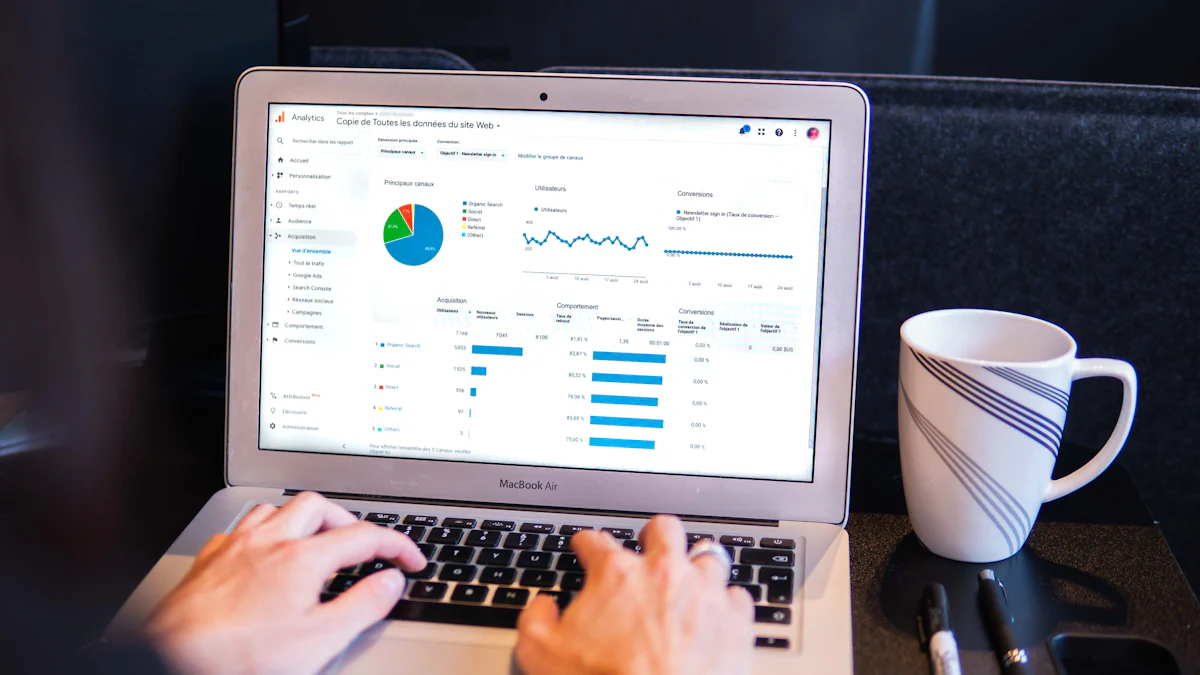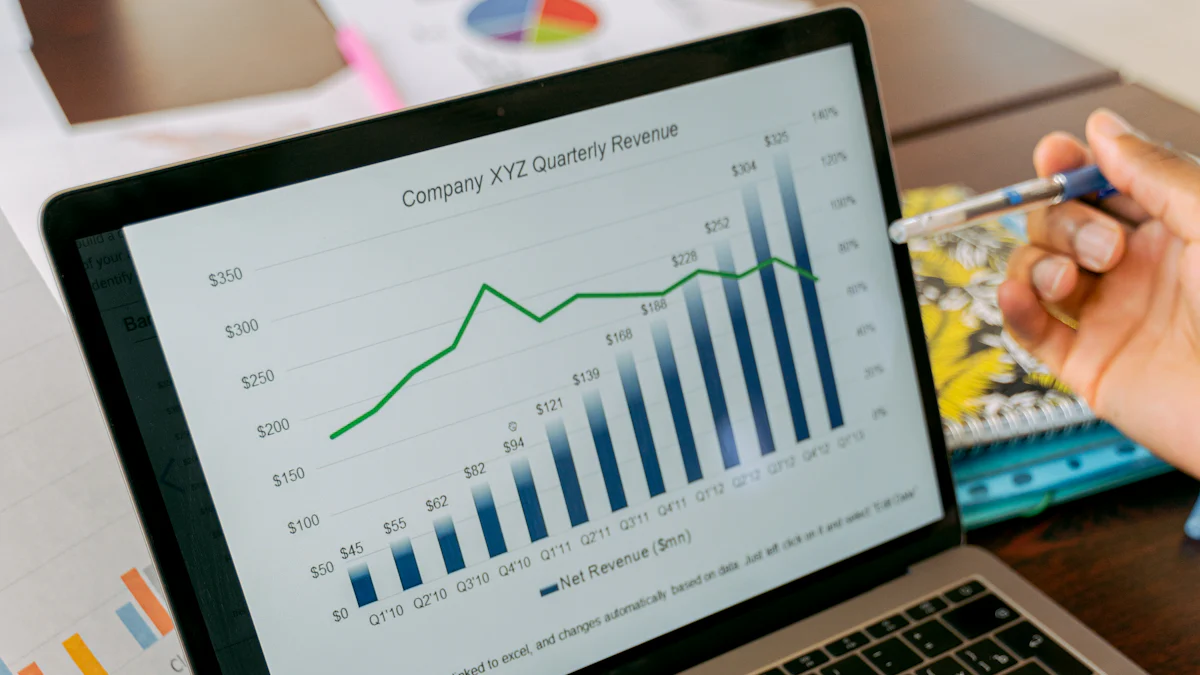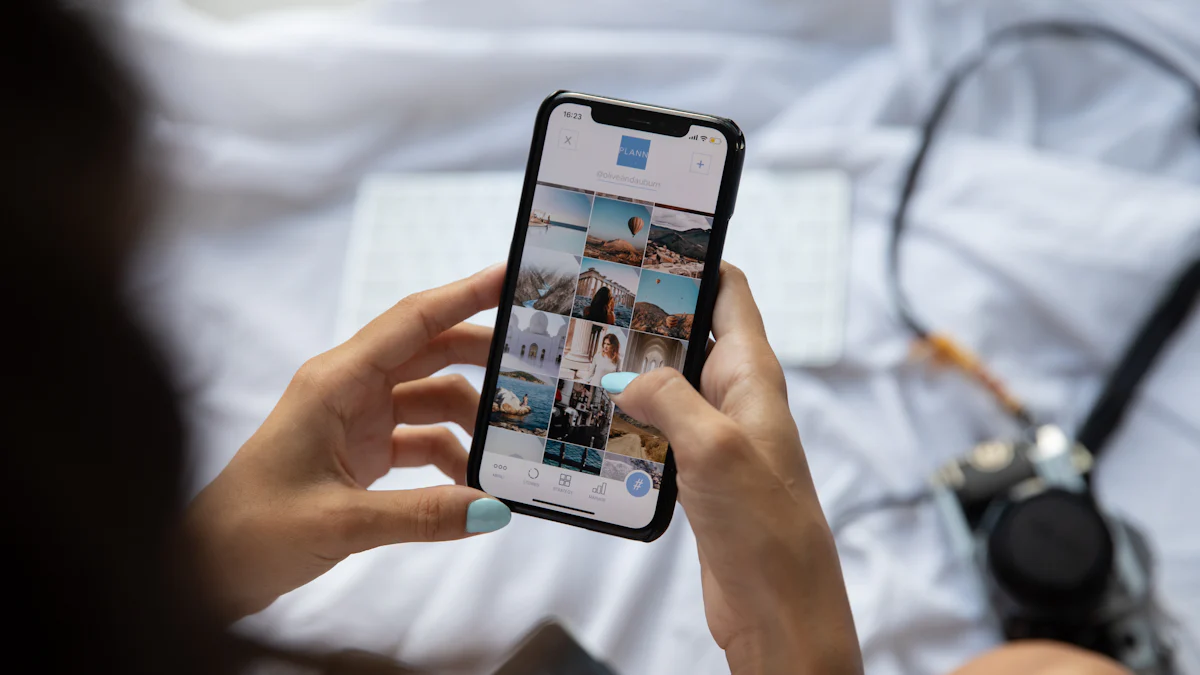Actionable Influencer Marketing Stats for Smarter Strategies

Data drives success in today’s marketing landscape. When you rely on numbers instead of guesswork, you unlock the potential for an effective influencer marketing strategy. Studies reveal that 83.8% of marketers report gaining higher-quality customers through influencer campaigns, while 89% say their ROI matches or exceeds other channels. These insights highlight the power of understanding influencer marketing stats. By analyzing trends and benchmarks, you can make smarter decisions, improve campaign performance, and stay ahead in a competitive market. Let data guide your approach to influencer partnerships and audience engagement.
Why Actionable Influencer Marketing Stats Matter
Understanding the importance of actionable influencer marketing stats can transform how you approach campaigns. Data empowers you to make informed decisions, avoid costly mistakes, and achieve better results. By leveraging insights, you can refine your strategies and maximize the impact of your influencer partnerships.
The Role of Data in Driving Smarter Strategies
Data serves as the backbone of effective influencer marketing. It helps you identify the right influencers, understand audience preferences, and measure campaign success. For example, analyzing engagement metrics allows you to choose influencers who resonate with their followers. This ensures your message reaches the right audience.
A data-driven approach enables you to customize campaigns based on audience insights. You can optimize content, timing, and platform selection to align with your goals. Unlike intuition, which relies on subjective judgment, data provides measurable benchmarks to guide your decisions.
Brands that use data also gain a clearer picture of ROI. You can track how much revenue your campaigns generate and compare it to other marketing channels. This clarity helps you allocate resources more effectively and justify your investments.
Challenges of Relying on Intuition Over Data
Relying on intuition in influencer marketing often leads to missed opportunities. Without data, you might select influencers based on popularity rather than relevance. This mismatch can result in low engagement and wasted budgets.
Intuition-based strategies also lack the precision needed to target specific demographics. For instance, you may overlook key audience segments or fail to align your messaging with their interests. This reduces the overall effectiveness of your campaigns.
Another challenge is the inability to measure success accurately. Without data, you cannot track performance or identify areas for improvement. This makes it harder to adapt and refine your strategies over time.
Benefits of Using Influencer Marketing Benchmarks
Influencer marketing benchmarks provide a roadmap for success. They offer insights into industry standards, helping you set realistic goals and expectations. For example, knowing average engagement rates by platform or influencer tier allows you to evaluate performance more effectively.
Benchmarks also help you identify trends and opportunities. You can spot emerging platforms, such as BeReal or Twitch, and adjust your strategy to stay ahead of competitors. Additionally, benchmarks highlight the growing impact of micro-influencers, who often deliver higher engagement rates than larger influencers.
By using benchmarks, you can measure your campaigns against industry norms. This helps you identify strengths, address weaknesses, and continuously improve your approach. Ultimately, benchmarks ensure your influencer marketing efforts remain data-driven and results-oriented.
Key Influencer Marketing Stats to Know

Understanding key influencer marketing stats can help you refine your strategies and achieve better results. Metrics like engagement rates, ROI benchmarks, and platform-specific performance provide valuable insights into what works and what doesn’t. Let’s explore these essential statistics to guide your next campaign.
Engagement Rates
Engagement rates measure how actively audiences interact with influencer content. This metric reflects the level of interest and connection between the influencer and their followers. High engagement often signals that the audience finds the content relatable and trustworthy.
Platform-Specific Engagement Benchmarks (Instagram, TikTok, YouTube)
Different platforms yield varying engagement levels. TikTok leads the pack, especially for influencers with smaller followings. Nano-influencers on TikTok, for instance, boast an impressive 18% engagement rate, far surpassing Instagram’s average of 2.05% and YouTube’s 3.5%.
Instagram, while still a dominant platform, has seen a decline in engagement over the years. Accounts with over a million followers now average just 0.95% engagement, compared to 1.97% in 2018. This drop highlights the growing challenge of maintaining audience interaction on saturated platforms.
TikTok’s higher engagement rates make it an attractive option for brands seeking active audience participation. However, Instagram and YouTube remain valuable for campaigns targeting specific demographics or content formats.
Engagement Rates by Influencer Tier (Nano, Micro, Macro, Mega)
The size of an influencer’s following significantly impacts engagement rates. Nano-influencers (fewer than 10,000 followers) often deliver the highest engagement, with rates reaching up to 18% on TikTok. Micro-influencers (10,000–50,000 followers) also perform well, offering a balance between reach and audience interaction.
Macro-influencers (50,000–1 million followers) and mega-influencers (over 1 million followers) tend to have lower engagement rates. For example, Instagram mega-influencers average just 0.95% engagement. While these influencers offer broader reach, their audiences may feel less connected to their content.
Choosing the right influencer tier depends on your campaign goals. If engagement is your priority, nano and micro-influencers often deliver better results.
ROI Benchmarks
Return on investment (ROI) is a critical metric for evaluating the success of influencer marketing campaigns. It helps you understand the financial impact of your efforts and compare them to other marketing channels.
Average ROI for Influencer Marketing Campaigns
Influencer marketing consistently delivers strong ROI. On average, campaigns achieve a 4.2% engagement rate, outperforming traditional paid media. This high level of audience interaction often translates into better conversions and customer acquisition.
ROI Comparison with Other Digital Marketing Channels
Compared to other digital marketing strategies, influencer marketing offers competitive ROI. While paid search and display ads focus on visibility, influencer campaigns excel at building trust and driving authentic engagement. This makes them particularly effective for brands aiming to connect with niche audiences.
Tracking ROI ensures you allocate resources wisely and maximize the value of your campaigns. Use analytics tools to measure revenue, engagement, and other key metrics.
Platform-Specific Performance
Each social media platform offers unique opportunities for influencer marketing. Understanding platform-specific trends can help you choose the best channels for your campaigns.
Top Platforms for Influencer Marketing in 2024
Instagram remains a top choice for influencer marketing, thanks to its visual focus and diverse user base. TikTok, however, continues to gain momentum, especially among younger audiences. Its short-form video format drives high engagement and viral potential.
YouTube also holds strong appeal, particularly for long-form content and tutorials. Its 3.5% engagement rate makes it a reliable platform for building deeper connections with audiences.
Emerging Platforms to Watch (e.g., BeReal, Twitch)
New platforms like BeReal and Twitch are reshaping the influencer marketing landscape. BeReal emphasizes authenticity, encouraging users to share unfiltered moments. This aligns with the growing demand for genuine content in influencer campaigns.
Twitch, a live-streaming platform, offers unique opportunities for real-time engagement. Brands can collaborate with influencers to host live events, product launches, or Q&A sessions, creating interactive experiences for viewers.
Staying ahead of platform trends ensures your campaigns remain relevant and effective. Experimenting with emerging platforms can help you reach untapped audiences and diversify your strategy.
Audience Demographics
Understanding audience demographics is essential for creating impactful influencer marketing campaigns. Demographics provide insights into the age, gender, location, and interests of an influencer’s followers. These details help you ensure your message reaches the right people and aligns with your brand’s goals.
Key Demographic Insights for Influencer Marketing
Demographic data reveals who engages with influencer content. For example, TikTok attracts a younger audience, with 41% of users aged 16–24. In contrast, Instagram has a broader age range, making it suitable for brands targeting diverse demographics. YouTube, known for its long-form content, appeals to audiences seeking in-depth tutorials or reviews.
By analyzing these trends, you can identify which platform best suits your target audience. For instance, if your brand focuses on Gen Z consumers, TikTok offers a higher chance of engagement due to its popularity among younger users.
Gender distribution also plays a significant role. Some platforms, like Pinterest, have a predominantly female user base, while others, such as Twitch, lean more male. Understanding these patterns ensures your campaigns resonate with the intended audience.
Additionally, geographic data helps you localize your strategy. If your brand operates in specific regions, collaborating with influencers whose followers match those locations increases the likelihood of success. For example, a U.S.-based brand might prioritize influencers with a majority American audience.
Aligning Influencer Demographics with Brand Goals
Matching influencer demographics with your brand’s objectives ensures your campaigns deliver meaningful results. Start by defining your target audience. Consider factors like age, gender, and interests. Then, evaluate potential influencers to see if their followers align with these criteria.
For example, if your brand sells eco-friendly products, partnering with influencers who advocate for sustainability attracts like-minded audiences. This alignment strengthens your message and builds trust with potential customers.
Use tools like audience analytics to assess an influencer’s follower demographics. Platforms like Instagram and TikTok provide insights into follower age, gender, and location. These metrics help you determine if the influencer’s audience matches your brand’s goals.
When selecting influencers, prioritize authenticity. Followers trust influencers who genuinely align with the brand they promote. Authentic partnerships lead to higher engagement and better campaign outcomes.
Remember, demographics are not just numbers. They represent real people who interact with your brand. Tailoring your influencer marketing strategy to these insights ensures your message resonates and drives results.
Emerging Trends in Influencer Marketing

Staying ahead of emerging trends in influencer marketing is essential for crafting impactful campaigns. As the landscape evolves, new opportunities arise to connect with audiences in innovative ways. Let’s explore three key trends shaping the future of influencer marketing.
The Rise of AI and Virtual Influencers
Artificial intelligence (AI) is revolutionizing influencer marketing by introducing virtual influencers—computer-generated personas designed to engage audiences. These digital influencers, such as Lil Miquela, have gained millions of followers on social media platforms. They offer brands a unique way to deliver consistent, controlled messaging while maintaining creativity.
AI also enhances campaign performance by providing advanced analytics and personalization tools. You can use AI to analyze audience behavior, predict trends, and optimize content strategies. For instance, AI-driven tools help identify influencers whose followers align with your target demographics, ensuring your message reaches the right audience.
Virtual influencers bring a level of authenticity that resonates with younger audiences. Despite being digital, they often share relatable stories and values, creating meaningful connections with followers. This blend of technology and storytelling opens new doors for brands seeking innovative engagement methods.
Growing Impact of Micro-Influencers and Nano-Influencers
Micro-influencers and nano-influencers are redefining the influencer marketing space. These creators, with smaller but highly engaged followings, deliver exceptional results for brands. Micro-influencers typically have 10,000–50,000 followers, while nano-influencers have fewer than 10,000. Their audiences trust their recommendations, making them ideal for driving authentic engagement.
Studies show that micro-influencers achieve higher engagement rates compared to larger influencers. For example, nano-influencers on TikTok boast engagement rates as high as 18%. This level of interaction reflects the strong connection they have with their followers, which translates into better campaign outcomes.
Collaborating with micro-influencers allows you to tap into niche communities. Their content feels personal and relatable, which builds trust and credibility for your brand. By focusing on quality over quantity, you can create campaigns that resonate deeply with your audience.
Cross-Channel Campaigns for Cohesive Strategies
Cross-channel campaigns are becoming a cornerstone of successful influencer marketing strategies. These campaigns leverage multiple social media platforms to create a unified brand message. By integrating content across channels like Instagram, TikTok, and YouTube, you can maximize reach and engagement.
For example, you might partner with an influencer to promote a product through Instagram Stories, TikTok videos, and a detailed YouTube review. This approach ensures your audience encounters consistent messaging, regardless of the platform they use. It also allows you to tailor content formats to suit each channel’s strengths.
Cross-channel strategies enhance your campaign’s effectiveness by diversifying your reach. They help you engage different audience segments while maintaining a cohesive brand identity. This approach ensures your marketing efforts remain versatile and impactful.
Live Shopping and Real-Time Engagement
Live shopping is transforming how brands connect with audiences. This trend combines the power of real-time interaction with the convenience of online shopping, creating a dynamic experience for consumers. Influencers play a pivotal role in these campaigns by showcasing products, answering questions, and driving immediate purchases during live streams.
Platforms like TikTok, Instagram, and YouTube have embraced live shopping features, making it easier for brands to integrate this strategy into their influencer marketing efforts. For example, an influencer might host a live session to demonstrate a product’s features, share personal experiences, and offer exclusive discounts. This approach fosters a sense of urgency and excitement, encouraging viewers to act quickly.
Studies reveal that 69% of consumers trust influencer recommendations more than direct brand promotions. Live shopping amplifies this trust by allowing influencers to engage authentically with their audience in real time. This interaction builds credibility and strengthens the connection between the brand and potential customers.
To maximize the impact of live shopping, focus on collaboration with micro-influencers. Their smaller but highly engaged audiences often respond more positively to these interactive sessions. Micro-influencers excel at creating relatable content, which resonates deeply with viewers and drives higher engagement during live events.
By leveraging live shopping, you can create immersive campaigns that blend entertainment with commerce. This strategy not only boosts sales but also enhances brand visibility and loyalty.
Prioritizing Authenticity and Transparency in Partnerships
Authenticity has become a cornerstone of successful influencer marketing. Audiences value genuine connections and can easily detect insincere endorsements. To build trust, prioritize partnerships with influencers who align with your brand’s values and message.
When selecting influencers, analyze their content and engagement patterns. Look for creators who consistently share honest opinions and maintain a strong rapport with their followers. Authentic influencers often have a deep understanding of their audience, enabling them to craft campaigns that feel natural and relatable.
Transparency is equally important. Disclose sponsored content clearly to maintain credibility. Research shows that audiences appreciate honesty, and transparent campaigns are more likely to foster long-term loyalty. Encourage influencers to share their personal experiences with your product, as this adds a layer of authenticity that resonates with viewers.
Micro-influencers are particularly effective in delivering authentic campaigns. Their smaller communities often perceive them as trustworthy and approachable. By collaborating with micro-influencers, you can tap into niche markets and create content that feels personal and impactful.
To ensure authenticity, avoid overly scripted campaigns. Allow influencers creative freedom to present your brand in a way that aligns with their unique style. This approach not only enhances the quality of the content but also strengthens the partnership between your brand and the influencer.
By prioritizing authenticity and transparency, you can build meaningful connections with your audience. These values not only improve campaign performance but also establish your brand as trustworthy and customer-focused.
How to Use Influencer Marketing Stats to Build Smarter Strategies
Data transforms your influencer marketing strategy from guesswork into a precise, results-driven process. By leveraging key statistics, you can set clear objectives, choose the right influencers, and measure campaign performance effectively. Let’s break down how you can use these insights to build smarter strategies.
Setting Clear Goals and KPIs
Clear goals form the foundation of any successful influencer marketing strategy. Without them, your campaigns risk lacking direction and measurable outcomes. Start by identifying what you want to achieve. Are you aiming to boost brand awareness, drive audience engagement, or increase conversions? Each goal requires a tailored approach.
Once you define your objectives, establish key performance indicators (KPIs) to track progress. For example:
- Brand awareness: Monitor metrics like reach, impressions, and follower growth.
- Audience engagement: Focus on likes, comments, shares, and click-through rates.
- Conversions: Measure sales, sign-ups, or downloads driven by the campaign.
Setting KPIs ensures you stay focused on measurable outcomes. It also helps you evaluate success and refine your strategy for future campaigns.
Choosing the Right Influencers
Selecting the right influencers is critical to achieving your campaign goals. The wrong choice can lead to wasted resources and minimal impact. Use data to guide your selection process and ensure alignment with your brand values and audience.
Evaluating Influencers Based on Engagement and Authenticity
Engagement rates reveal how well an influencer connects with their audience. High engagement indicates that followers trust and interact with their content. Nano and micro-influencers often excel in this area, offering authentic collaborations that resonate deeply with niche communities.
Authenticity plays an equally important role. Audiences value influencers who genuinely align with the brands they promote. Analyze an influencer’s past partnerships and content style to assess their authenticity. Look for creators who share honest opinions and maintain a strong rapport with their followers.
As Mary Ann O’Brien, an expert in AI influencer marketing, emphasizes, “Brands that carefully align campaigns with the interests, opinions, wants, and needs of their audiences while remaining true to their core brand identity will come out on top.”
Tools for Influencer Discovery and Vetting
Finding the perfect influencer no longer requires hours of manual research. AI-driven tools streamline the process by providing customized lists based on specific criteria like audience demographics, engagement rates, and interests. Platforms like Aspire and Upfluence allow you to vet influencers efficiently and ensure they match your campaign goals.
According to LaBoy, an expert in AI-driven influencer marketing tools, these platforms save time and improve accuracy. They help you identify influencers whose followers align with your target audience, increasing the likelihood of campaign success.
Measuring Campaign Success
Tracking performance is essential to understanding the impact of your influencer marketing strategy. Without proper measurement, you cannot determine whether your efforts are delivering the desired results.
Key Metrics to Track (Reach, Engagement, Conversions)
Focus on metrics that align with your campaign objectives. For example:
- Reach: Measures how many people saw your content. This metric is crucial for brand awareness campaigns.
- Engagement: Tracks likes, comments, shares, and other interactions. High engagement indicates strong audience interest and connection.
- Conversions: Reflects the number of actions taken, such as purchases or sign-ups. This metric directly ties to ROI and campaign performance.
Regularly monitoring these metrics helps you identify what works and what doesn’t, allowing you to optimize your strategy in real time.
Leveraging Analytics Tools for Continuous Improvement
Analytics tools provide valuable insights into campaign performance. Platforms like Google Analytics, Sprout Social, and Hootsuite allow you to track key metrics and generate detailed reports. Use these tools to compare your results against industry benchmarks and uncover areas for improvement.
For example, if your engagement rates fall below average, consider adjusting your content strategy or collaborating with different influencers. Continuous analysis ensures your campaigns evolve and remain effective.
Frederik Bussler, an expert in AI influencer marketing, predicts that brands will increasingly use AI to analyze audience behavior and optimize content strategies. This approach enhances campaign performance and ensures your efforts stay data-driven.
By setting clear goals, choosing the right influencers, and measuring success effectively, you can create an influencer marketing strategy that delivers tangible results. Data empowers you to make informed decisions, refine your approach, and achieve long-term success.
Leveraging influencer marketing stats empowers you to craft smarter strategies that drive meaningful results. By focusing on key metrics like engagement rates and ROI, you can refine your campaigns for maximum impact. Emerging trends, such as live shopping and the growing influence of micro-influencers, offer exciting opportunities to connect with audiences authentically. Platforms like TikTok and Instagram continue to dominate, while new channels like Twitch are reshaping the landscape. Adopting a data-driven approach ensures your influencer marketing efforts remain effective and adaptable in the ever-evolving world of social media.
FAQ
What is the importance of using data in influencer marketing?
Data helps you make informed decisions that improve campaign outcomes. Instead of relying on guesswork, you can analyze metrics like engagement rates, audience demographics, and ROI to guide your strategy. This approach ensures your campaigns align with your goals and resonate with your target audience. As marketers emphasize, data allows you to look beyond vanity metrics like follower counts and focus on meaningful insights that drive results.
How do I set realistic goals for my influencer marketing campaigns?
Start by defining what you want to achieve. Common goals include increasing brand awareness, boosting engagement, or driving sales. Use data to establish benchmarks and key performance indicators (KPIs). For example, if your goal is engagement, track metrics like likes, comments, and shares. Clear goals and measurable KPIs keep your campaigns focused and help you evaluate success effectively.
How can I choose the right influencers for my brand?
Look for influencers whose audience aligns with your brand’s values and target demographics. Analyze their engagement rates to ensure they connect with their followers. Tools like Aspire and Upfluence can help you discover and vet influencers based on criteria like authenticity, audience behavior, and content style. Remember, smaller influencers like nano and micro-influencers often deliver higher engagement and build stronger trust with their audiences.
Why are engagement rates more important than follower counts?
Engagement rates show how actively an influencer’s audience interacts with their content. High engagement indicates trust and interest, which are critical for campaign success. Follower counts, on the other hand, can be misleading. An influencer with millions of followers but low engagement may not deliver meaningful results. Focus on influencers who foster genuine connections with their audience.
What platforms should I prioritize for influencer marketing?
The best platform depends on your target audience and campaign goals. Instagram remains a top choice for visual content and diverse demographics. TikTok excels in short-form videos and younger audiences, while YouTube is ideal for long-form tutorials and reviews. Emerging platforms like BeReal and Twitch offer unique opportunities for authenticity and real-time engagement. Analyze platform-specific trends to determine where your audience spends their time.
How do I measure the success of my influencer marketing campaigns?
Track metrics that align with your goals. For brand awareness, monitor reach and impressions. For engagement, focus on likes, comments, and shares. For conversions, measure sales or sign-ups generated by the campaign. Use analytics tools like Google Analytics or Sprout Social to gather data and compare your results against industry benchmarks. Regularly reviewing these metrics helps you refine your strategy.
What are the benefits of working with micro-influencers and nano-influencers?
Micro-influencers (10,000–50,000 followers) and nano-influencers (fewer than 10,000 followers) often deliver higher engagement rates than larger influencers. Their smaller audiences trust their recommendations, making them ideal for building authentic connections. Collaborating with these influencers allows you to tap into niche communities and create relatable content that resonates deeply with your target audience.
How can I ensure authenticity in influencer partnerships?
Choose influencers who genuinely align with your brand’s values and message. Review their past content and partnerships to assess their authenticity. Allow them creative freedom to present your product in a way that feels natural to their audience. Transparency is also key—clearly disclose sponsored content to maintain trust. Authentic partnerships lead to stronger connections and better campaign outcomes.
What role does live shopping play in influencer marketing?
Live shopping combines real-time interaction with online purchasing, creating an engaging experience for consumers. Influencers showcase products, answer questions, and drive immediate sales during live streams. Platforms like TikTok, Instagram, and YouTube offer live shopping features. This strategy builds trust and excitement, encouraging viewers to act quickly. Collaborating with micro-influencers for live shopping often yields higher engagement.
How can I stay ahead of influencer marketing trends?
Stay updated on emerging platforms and innovative strategies. For example, AI-driven tools are transforming how brands discover influencers and optimize campaigns. Virtual influencers and live shopping are reshaping engagement methods. Focus on trends like cross-channel campaigns and the growing impact of micro-influencers. Regularly analyze industry reports and adapt your strategy to remain competitive in the evolving landscape.
See Also
Decoding The Return On Investment In Influencer Marketing
Key Influencer Marketing Trends To Follow In 2024
Effective TikTok Influencer Marketing Tactics For 2024
